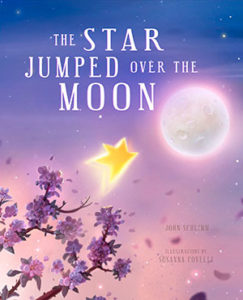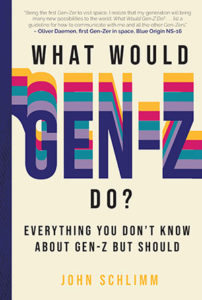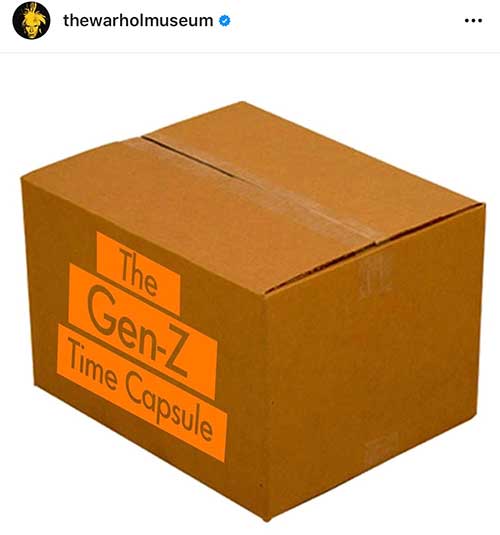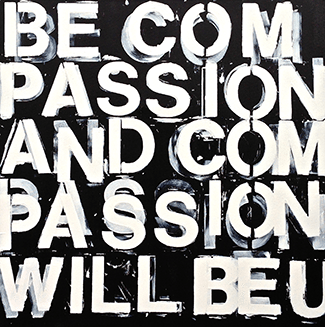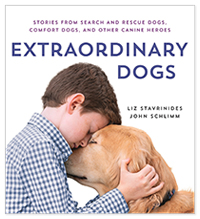
Extraordinary Dogs
Stories From Search and Rescue Dogs, Comfort Dogs, and Other Canine Heroes
Photographs By Liz Stavrinides
Essays By John Schlimm
St. Martin’s Press
Book Club Discussion Questions
Extraordinary Dogs portrays more than 50 working dogs, along with the police officers, firefighters, veterans, and other trained volunteer handlers who serve side-by-side with them. Their moving stories and beautiful photographs are an unprecedented glimpse at Comfort Dogs and Search and Rescue Dogs, along with bomb-detecting TSA dogs and canine ambassadors from across the United States.
Read individually or collectively, among the 40 essays in Extraordinary Dogs there several launching points for discussion about the numerous questions and topics we all confront in our lives every day. From personal and headlining national tragedies, trauma, and healing to love, hope, courage, compassion, service, faith, connection, and everyday heroism, the following discussion questions will allow you to further explore and actively engage with the stories shared throughout the book.
- Which essay or story in Extraordinary Dogs inspired or impacted you the most? Please explain.
- What is the greatest lesson you learned from the essays in Extraordinary Dogs?
- In what ways did the stories in Extraordinary Dogs support or change the way you think about dogs or other animals?
- Do you currently have, or have you ever had, a pet or other special animal in your life? If so, what lessons did you learn from them?
- Every dog and handler in Extraordinary Dogs exemplifies courage and heroism in various ways. What were the most inspiring and impactful examples of courage and heroism to you personally within these essays? How did these stories affect your understanding of courage and heroism?
- Many of the essays in Extraordinary Dogs take you behind the scenes of some of the country’s biggest headlining tragedies and disasters. How did these first-hand accounts of the dogs and handlers impact the way you previously thought about these events?
- What did the stories in Extraordinary Dogs teach you about the connection between people and dogs or other animals?
- After reading the essays in Extraordinary Dogs, how have the meanings of the following words and emotions changed for you: Love, hope, joy, compassion, faith, healing, courage, hero, volunteer, and community service?
- What did the essays in Extraordinary Dogs teach you about people and the human spirit?
- What do you think it is about dogs that make them perfect for both working with and working to help people, whether it is as Search and Rescue dogs, TSA dogs, Comfort Dogs, service dogs, or as canine ambassadors?
- After reading the essays in Extraordinary Dogs, how do you think your community could benefit from dogs? Or, are there ways in which dogs and other animals already impact your community in a positive way?
- In what ways did the dogs portrayed in Extraordinary Dogs demonstrate that dogs and other animals can be good for our mind, body, and spirit?
- In what ways is Extraordinary Dogs a call to action—locally, regionally, and nationally? How can you put this call to action into practice within your own life?
- The majority of the handlers portrayed in Extraordinary Dogs are volunteers for the respective organizations. Are you a volunteer in some way? If so, where do you volunteer? How has volunteering affected you? After reading these stories, how has your idea of volunteering changed?
- Totally impossible question to answer, but here it goes: Which dog in Extraordinary Dogs is your favorite, and why?
BONUS: Two sets of pages were left blank at the end of Extraordinary Dogs after the Acknowledgments section. John and Liz encourage you to now add photos of the extraordinary dogs in your life, along with a few words about how very special they are to you.
The Organizations in Extraordinary Dogs:
To learn more about the organizations in Extraordinary Dogs, or to follow them on social media, please visit:
Lutheran Church Charities
www.LutheranChurchCharities.org
National Disaster Search Dog Foundation
www.SearchDogFoundation.org
Puppy Prodigies
www.SurfDogRicochet.com
Returning Soldier Initiative
www.ReturningSoldierInitiative.com
Search and Rescue Dogs of the United States
www.sardogsus.org
Transportation Security Administration
www.tsa.gov
The Vanderpump Dog Foundation
www.VanderpumpDogs.org
About the Author
John Schlimm is a Harvard-trained educator, artist, activist, and the award-winning author of 18 previous books, including his memoir Five Years in Heaven. A longtime advocate for dogs and other causes, John is also the creator of the Participatory Art pieces Planting COMPASSION and THE SMILE THAT CHANGED THE WORLD (is yours), which have been installed across the country. He has appeared on such national media outlets as The Ellen DeGeneres Show, Bravo’s Watch What Happens Live, Martha Stewart’s Everyday Living, NPR, QVC, and The Splendid Table.
For more information about John, please visit: www.JohnSchlimm.com
About the Photographer
Liz Stavrinides is a critically-acclaimed photographer and author of Miracle Dogs Rescue Stories. Combining her passion for photography with her infinite love of dogs, Liz’s uniquely creative style emanates from her lifelong pursuit of being a professional photographer. In addition to also photographing people, architecture, and interiors, Liz has particularly combined two of her greatest passions in life—her love for animals and photography—into a meaningful career. Unleashing her creative eye in the studio and on location, Liz exclusively uses FUJIFILM X/GFX Series cameras. Her work has been published and exhibited widely, including in Modern Cat, Carmel Magazine, Pebble Beach–The Magazine, Coastal Canine, and FujiLove Magazine.
For more information about Liz, please visit: www.lovedogandco.com
To request a Skype or in-person visit by John or Liz to your book club, please contact:
Steve Troha
Folio Literary Management
steve@foliolit.com
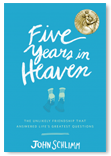
Five Years in Heaven
One of the great joys of sending Five Years in Heaven out into the world has been getting to meet with so many book clubs around the country, either in person or via Skype.
Below I have listed some discussion questions to get you and your book club started on your journey with Five Years in Heaven.
To further help to maximize your book club’s experience with the memoir, in the paperback edition of Five Years in Heaven, I included a chapter-by-chapter Reader’s Guide with discussion questions at the end.
If you are interested in choosing Five Years in Heaven as your next book club selection, and would like signed bookplates or to schedule a Skype visit with me during your book club meeting, please contact Steve Troha at steve@foliolit.com.
Five Years in Heaven
Book Club Discussion Questions
Five Years in Heaven presents several launching points for discussion about the numerous questions and topics we all confront in our lives every day. From forgiveness, death, and even the existence of God, to love, success, creativity, sin, relationships, and numerous other daily challenges, the following discussion questions will allow you to further explore and actively engage with the wisdom, humor, and lessons shared throughout the book.
This companion guide will direct you toward discovering your own Heaven on earth, and your own meanings to the universal questions and topics that Sister Augustine and John discuss.
1. At the beginning of Five Years in Heaven, John finds himself at a crucial crossroads in life. When in your life have you found yourself at a crossroads like John did?
2. John initially questions how sorrow can be a “gift,” as Sister Augustine calls it, which should be greeted with gratitude. Have you ever found sorrow to be a gift in your life? Explain.
3. Just as John experienced, when have you realized that a great teacher entered your life? What lessons did you learn from that teacher?
4. Sister Augustine says of creating ceramic pieces: “This process is a slow one that tests each piece along the way over time. More often than not, they’re tougher than you’d think by just looking at them.” How can you relate this sentiment to your life?
5. Sister Augustine says: “That’s when gratitude counts the most. It’s in those challenging moments when we get a little closer to our true purpose in this life. We need to be thankful for those challenges.” Think of a disappointment or challenge in your life. How can being grateful for that situation help you to move through it into a better place?
6. John writes: “It’s so hard to have faith in a greater purpose that you can’t see or easily explain. Or to find belief in a world that no longer seems to believe in you.” Have you ever felt this way? Explain.
7. Sister Augustine tells John: “God has His ways. His reasoning may not seem obvious to us at the time, but someday you’ll look back and say, ‘That’s exactly how my life had to happen, good andbad, right down to the second, to get me where I am.’” How does your life journey so far support this sentiment?
8. Sister Augustine tells John: “Forgiveness is an act of love and compassion. Yes, it is a gift we give to the person who hurt us, which is often the hardest part for people to understand. In our minds, that often means we’re letting that person off the hook for whatever they did to us. But ultimately, when we forgive someone, that act is also a gift of love and compassion, andfreedom, that only we can give to ourselves.” How did this statement support or change how you view the act of forgiveness?
9. In discussing our pursuit to know God, Sister Augustine says: “We have to see, with our entire bodies and souls, before we can truly understand.” Besides your eyes, how else can/do you “see” God at work in your life?
10. While at one time or another we all stand before a wall of fear and challenges, Sister says: “The difference for some, though, is that they look upward and think, I can climb right up over this wall. Or they look to the sides, and think, I can go around this wall. Or, if nothing else, they take a step back and carefully examine the wall, thinking, I can smash right through it!” When in your life have you taken this proactive approach to overcoming fear, change, or some other challenge?
11. Sister Augustine says: “One of the most important things in this life is just showing up. . . . That speaks for itself, where words never could. Just like a smile does.” What is an example from your life when “just showing up” made an important difference?
12. Sister Augustine says: “That’s what life is meant to be: an unfinished piece of work that others carry on in some way after you’ve gone. That way there truly is no beginning and no end.” Did this statement influence your own views on living and dying? Explain.
13. John writes about how his friendship with Sister Augustine ultimately transformed him. Think of a close friendship you have or had with someone. In what ways did that friendship transform you for the better and help guide you along life’s journey?
14. From the beginning, Five Years in Heavenhas explored the topic of Heaven on earth. When in your life have you had an experience that you would describe as Heaven on earth?
15. John ends the book with a simple reaction. Why in that moment do you think that was his reaction? How does this seemingly simple reaction reflect his growth in the five-year journey he just completed?
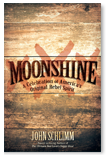
Moonshine: A Celebration of America's Original Rebel Spirit
I want to help you add even more FUN and BUZZ to your book club!
I love book clubs, and I love moonshine!
I’ve gotten to visit with book clubs all over the country—some in person and others via Skype. Each time, I’ve found these groups of friends and neighbors to be the best of the best when it comes to love, laughter, and simply enjoying one another’s company.
Book clubs have also perfected something else after my own heart: the art of having a great time while simultaneously discussing books and enjoying scrumptious cocktails and savory snacks. You are my kind of folks!
For Moonshine: A Celebration of America’s Original Rebel Spirit, I want to really show the love when it comes to your book club and do something extra special for you and your friends. After all, we’re talking about a story 250 years in the making, along with a collection of 100+ handcrafted moonshine infusion and specialty cocktail recipes.
Please consider me the co-host for your Moonshine Book Club gathering.
If you are interested in choosing Moonshine as your next book club selection, I have listed some discussion questions below to get you started.
Also, if you would like moonshine cocktail and snack recipes, signed bookplates, and even a visit from me via Skype, please email Ann Pryor, Senior Communications Manager at Kensington Publishing Corp., at apryor@kensingtonbooks.com.
Moonshine Book Club Discussion Questions
There are many topics you can explore when discussing the 250-year history of the moonshiners. The following questions are only meant as suggestions. Feel free to take your Moonshine Book Club discussion in any direction you all choose—just be sure there are plenty of cocktails and snacks to go around.
1. The history of the moonshiners is interwoven with the larger history of the United States, from the time it was a new nation onward. In what ways did this intimate connection between a group of citizens and our country surprise you?
2. What was your favorite fun fact that you learned about moonshine or the moonshiners?
3. In what ways did the moonshiners demonstrate that they were naturally savvy and wise at doing business?
4. In what ways is the story of the moonshiners a uniquely American story?
5. Of all the moonshiners—and other real-life characters—mentioned in Moonshine, who was your favorite and why?
6. Moonshine has appeared in many movies, TV shows, and songs. What are some of your favorite appearances by moonshine in the entertainment world?
7. Do you have any personal or family connections to moonshine or moonshiners, past or present? If so, please share.
8. In what ways do the moonshiners and their lives serve as empowering and inspiring role models for us in today’s world?
9. If you could go back in time and be a moonshiner, would you? Why or why not?
10. Of the 100+ handcrafted infusions and cocktails in Moonshine, which one do you most want to try?

